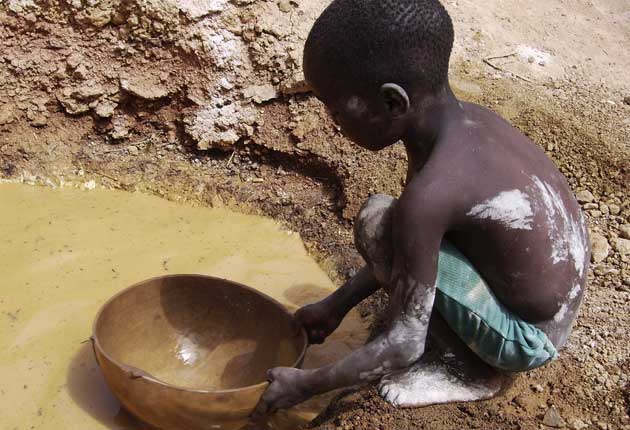Scandal of 'dirty gold' on British high streets

Sales staff at leading retailers misled shoppers about the origin of gold jewellery during an investigation into the real story behind gold rings, bangles and bracelets on sale on the high street, the i can reveal.
Campaigners claim the use of child labour and toxic metals is rife in developing countries which supply the multibillion pound global trade in "dirty gold".
But when Channel 4's Dispatches show asked leading high-street chains where their gold originated, they came up with misleading answers in an attempt to reassure customers their products were "ethical". Experts say dirty gold accounts for between 10 and 30 per cent of global supply, but the origin of gold sold by UK retailers is not known.
The Dispatches documentary, The Real Price of Gold, to be aired on Monday, travelled to Senegal in Africa, where a 14-year-old boy, Djimbe Sidibe, was working in unsafe deep mines – and panning for gold using toxic mercury.
In other scenes from the programme, pictures were shown of children who had allegedly been made ill by pollution from a nearby mine owned by a mining corporation. A representative of another company suggested that the industry knew some gold finding its way on to international markets was mined by children in dangerous conditions.
Asked the risks of mining in developing countries, the sales manager for Cookson Precious Metals told an undercover reporter: "Mercury's most effective way of mining gold, but, yeah, they're sending the kids down there, they're digging on the rocks so hard they're just going to fall on them... it's horrific. But... they're driven to it by poverty, they have to do it to stay alive." The firm, he said, bought gold from banks who would not guarantees it had been ethically mined. Cookson later said the comments were "not representative of the company's position".
Dispatches suggested consumers should seek out more recycled gold – made from melted down old jewellery – to reduce the reliance on dirty gold, though that would reduce the income to miners in developing countries.
The Fairtrade Foundation said: "It has been impossible for consumers to know where the gold in an item of jewellery was mined. But now more want to be sure gold they are buying has not caused harm to communities or the environment."
£86bn was spent globally on gold jewellery in 2010. India and the Middle East are the biggest consumers. The UK is the second-largest gold jewellery market in Europe after Italy.
According to research by Oxfam, to make one 0.33oz wedding ring generates on average 20 tonnes of mine waste.
Two-thirds of newly mined gold is extracted from immense open-pit mines‚ some of which can even be seen from outer space.
Even if the gold is close to the surface, the simplest open-pit mine can take up to a year to build. The time between discovering gold and actually bringing it out of the earth can be up to five years.
An estimated 15 million people work in artisanal and small-scale mines worldwide, often enduring poor working conditions and exposure to highly toxic chemicals such as mercury. Despite producing just 10 per cent of global gold supplies, these mines account for 90 per cent of the labour force in gold extraction.
China is the largest producer of gold in the world, producing 340.88 tonnes in 2010, up 8.57 per cent on the previous year. Australia is the second-largest gold producer in the world, with 215 tonnes in 2010, followed by South Africa.
Richard Hall
Subscribe to Independent Premium to bookmark this article
Want to bookmark your favourite articles and stories to read or reference later? Start your Independent Premium subscription today.

Join our commenting forum
Join thought-provoking conversations, follow other Independent readers and see their replies